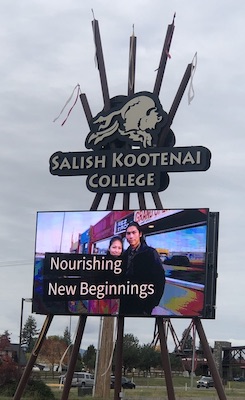Tribal College and CHTC pursue opportunities to expand computing education and infrastructure
Malia Bicoy January 17, 2024
Salish Kootenai College and CHTC take steps toward bringing underrepresented communities to cyberinfrastructure.
Access to cyberinfrastructure (CI) is the bedrock foundation essential for students and researchers determined to contribute to science. That’s why Lee Slater, the Cyberinfrastructure Facilitator at Salish Kootenai College (SKC), a tribal community college in northwest Montana, first brought up the “missing millions.” The term was coined after the National Science Foundation (NSF) reported that users and providers of the CI as a whole do not accurately represent society. Underrepresented racial and gender demographics were largely missing from the field. “[The missing millions] just don’t have access to high performance computing platforms and so they’re not contributing greatly to the scientific body of knowledge that other privileged students have access to,” Slater explained. “It’s a real serious deficit for these students. One of the goals we’re trying to get accomplished is to bring these educational and research platforms to students and faculty to really enrich the experience they have as students.”
SKC inhabits an indigenous reserve known as the Flathead Reservation, which includes territory in four western states. Established in 1855, the reservation is home to the Confederated Salish and Kootenai Tribes. SKC — with just over 600 students — makes up a small, but vital portion of the much larger reservation. The college consists largely of tribal descendents or members, making up almost 80 percent of the school population.

The Center for High Throughput Computing (CHTC) Director Miron Livny traveled to Montana this past October to meet with Salish Kootenai College faculty and staff. The four-day trip was coordinated by International Networking Coordinator Dale Smith from the University of Oregon, who also works for the American Indian Higher Education Consortium. The visit was meant for Livny to experience one of the nation’s tribal colleges and universities (TCUs) and to further the discourse between CHTC and SKC. “The main goal was for him to see our infrastructure, meet the faculty and see research opportunities,” Slater recalled.
SKC’s biggest and most immediate computing goal is to provide the access and training to utilize a web platform for JupyterHub that would be available for faculty and student use. The Jupyter Notebook connects with an OSPool Access Point, where students can place their workloads and data and which automates the execution of jobs and data movement across associated resources. Slater believes this would be beneficial, as many SKC faculty members do computing and data analysis within their specialties. “The fact that we could have a web platform with JupyterHub that students could access and faculty could access would really be a great facilitation,” Slater explained.
Slater would also like to collaborate with other TCUs, train faculty in computing software and overall increase their cyberinfrastructure capabilities. SKC Chief Information Officer (CIO) Al Anderson would like to leverage storage capacity for a faculty researcher who is examining the novel behavior of elk on the National Bison Range. This work requires taking a vast amount of photographs that then must be processed and stored. “We found that we have this storage issue — right now they’re using portable hard drives and it’s just a mess,” Anderson said.
Engagements like this are an early, but important step in bringing underserved communities to cyberinfrastructure and thus to science and research. The NSF “Missing Millions” report focused on the need for democratizing access to computing and showed a deficiency of engagement with institutions created for marginalized groups. Institutions like historically black colleges and universities (HBCUs) and TCUs tend to lack cyberinfrastructure capabilities that can be hard to implement without engagement from outside institutions. SKC’s engagement with CHTC is an example of steps both are taking in addressing this deficiency.
Longer term goals for the college are largely educational-focused. “We’re a small school, traditionally we have more educational needs than really heavy research needs,” Slater said. Anderson agreed stating, “I think a lot of our focus is the educational side of computing and how to get people hooked into those things.”
Anderson and Slater are also focused on relationship-building with faculty and discovering what they need to educate their students. They believe hearing from the SKC community should be first and foremost. “We’re still in that formative stage of asking, what do we need to support?” Anderson explained, “Through these conversations we’re slowly discovering.”
